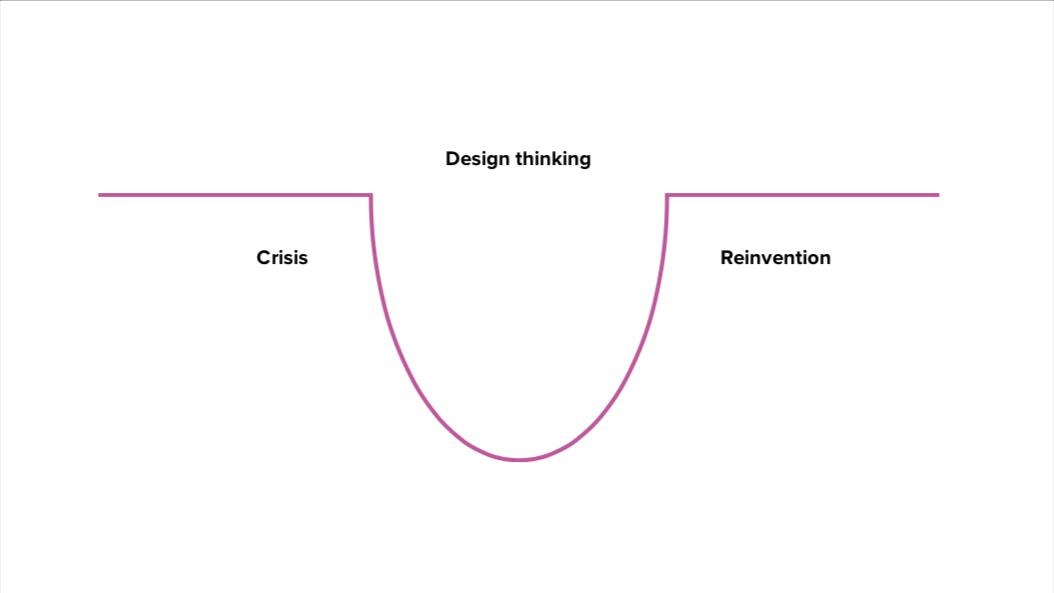In this two-part series, we explore the value and practice of Design Thinking! You’ve probably heard the term thrown around the office or maybe among your tech and design teams, but do you know why it’s so popular? What does it mean? How can it actually be applied to solve problems?
In this post, we illustrate exactly what design thinking is and why so much value lies in utilizing it to solve service, product, and business challenges. In Part Two, we’ll jump into explaining the Design Thinking Process and how to use design-thinking principles for business.
So what is design thinking?
First, it’s key to point out that design influences our daily lives, whether we notice it or not. Design is everywhere. Every human experience with a product, service, company, or space is designed (for better or worse, intentionally or unintentionally). Walking through a hotel lobby or an airport departure gate, for example, are both designed experiences. Complicated parking signage, push/pull doorways, confusing business workflows… you name it, design thinking has the potential to help reinvent the intentionality and user experience of just about anything humans use and encounter.
Design thinking is a human-centered approach to problem solving.
There are many definitions out there, but we find the one above speaks best to design thinking’s core elements. Design thinking is primarily human-centered, which means that it really focuses on who the customers or end-users are––the actual people having a particular problem or experience. We explore human-centered design (HCD) and research in a previous blog series, and the two mindsets are certainly linked. For example, design thinkers might utilize listener-based research (like in-depth user interviews) to identify a user, customer, citizen, or employee’s main challenges, and from there identify what larger, more central problems might be in order to begin brainstorming new ideas to solve the problem. The overall end goal is to improve the human experience!
The Value of Design Thinking
This is a really good time for businesses to begin applying design thinking. With many industries presently transforming the way they operate, user/customer experience is shifting at light speed. And, several studies conducted over the past 5-10 years clearly illustrate that embracing design-thinking principles is a very smart business move.
The Design Management Institute (DMI) has reported that design-led companies maintain a significant stock market advantage, outperforming their competition on the S&P index by 211% (!!)
This suggests that good design matters for every company, regardless of sector.
As well, a recent McKinsey study has found that leaders and companies who embrace design thinking are more likely to grow (revenue wise) sometimes twice as fast as their competitors. In other words, C-suites and company managers who make strategic decisions based on research and data, in collaboration with multiple departments and stakeholders, are simply more successful.
Human-centered design (HCD) and design-thinking mindsets in business also equate stronger customer/user experiences. Users and buyers––especially young people––care much more today about efficiency, ease of use, and customer experience, and much less about staying true to one particular brand.
At the same time, our world is literally in crisis mode. Businesses and governments are struggling to reinvent how we live and work in light of COVID-19. This includes challenges related to the environment and climate change, and massive shifts within health care, education, travel and hospitality, entertainment, and retail. Not to mention how workplace culture has been impacted within all of these sectors, too!
Design thinking principles, when applied, can literally help bridge the gap between crisis and innovation or reinvention by offering concrete research data showing what customers/users really need and want, and enabling companies to make strategic product and service decisions using insights. This empowers teams to ideate and come up with better designs––and better ways of doing things. New concepts can be refined on-the-go by collecting feedback, while meeting business goals and user needs at the same time.
This process also enables teams to innovate within and despite resource constraints, by pulling together what’s desirable from a human point of view with what’s technologically feasible and economically viable.
In fact, to create real solutions to real problems, you need to consider:
-
desirability (i.e. do real customers actually want and need this product/service?)
-
the viability (in terms of industry trends and business goals– does this product/service make sense?), and
-
feasibility (does the right budget and technology exist to execute this product/service?)
Where these three key elements meet is the “sweet spot” for innovation!
Design thinking also includes the concept of systems thinking: the process of understanding how components of a system influence each other as well as other systems. Design thinking practices don’t exist in a vacuum––you have to consider other stakeholders involved, other organizations involved, supply chains, users, front-end and back-end workers delivering the service or product, and global or industry trends. Design thinking also takes into account business goals, budgets, and access to resources. It’s important to consider all the moving parts within a given “system”.
As well, design-thinking frameworks are best used for what designers call “wicked problems”. This is a problem that is difficult to solve because of its complex and interconnected nature. Wicked problems have real-world, sometimes contradictory and changing requirements, as the illustration below shows. For example, climate change or poverty could be considered two wicked problems––they involve so many different actors and scenarios, it’s difficult to say where you would even start trying to tackle these issues.
View this post on Instagram
Consider a workflow at your business that you know is inefficient and could be improved. Maybe you aren’t quite sure why it doesn’t work––it might involve many teams/departments and seem very daunting to tackle––but you do know there must be a better way to approach this workflow. Or maybe your company knows that some of its customers are not happy. Customers are experiencing long wait times when they call the help desk, only to receive confusing and contradictory information from support staff. You can’t pinpoint exactly what the issue is… but you definitely know there is a problem! This is where design thinking can step in. Design-thinking practices are great for understanding users and finding solutions to complex business challenges.
At its core then, design thinking is valuable because it is:
-
Human-centered (focusing on human experiences above all else)
-
Collaborative and multidisciplinary (it’s crucial to involve people with different perspectives, backgrounds, and experiences)
-
Highly creative (imagination and whimsy are encouraged, particularly in the early stages of the process)
-
Focused on action (outcomes and solutions are intended to be highly actionable and concrete), and
-
Iterative (testing and gathering feedback as you go are intrinsic to the process).
At the same time, design thinking is NOT:
-
Just visual/graphic design (how it looks)
-
A one-size-fits-all solution, or
-
Just for designers.
Anyone can use a design-thinking framework to empower their teams, get creative, toss up some big ideas, and see what works through research, ideation, testing, and collecting feedback.
Design Thinking & Risk
Something else to remember is that engaging in small-scale risk is healthy for organizations, and part of design-thinking practices. We always remind our clients that failure isn’t necessarily a “bad” thing, especially when you’re in the exploratory/discovery phase of creating a new product/service or solving a problem. When you’re engaged in design thinking, teams should feel safe “failing” and course-correcting as they go––that’s at the essence of design, whether you’re creating a new product, feature, or service. Testing and gathering feedback (and testing again…and again) is part of the small-scale risk required to succeed. And over the long term, this process will reduce risk by saving you from investing lots of time and money into products, services, or solutions that fail because there was a lack of testing and iteration in the place
Essentially, design thinking can help to:
-
Increase retention and satisfaction by helping teams better understand the unmet needs of users and customers
-
Reduce the risk associated with launching new ideas, products, and services
-
Generate solutions that are revolutionary, not just incremental
-
Foster an employee culture that embraces questioning and creativity, and
-
Save you money by learning what works early on in the process.
In Part Two of this series, we explore the Design Thinking Process in more depth, as well as great tools like Empathy Mapping, User Personas, and more that you can use to get started!







